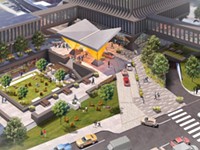[
{
"name": "500x250 Ad",
"insertPoint": "5",
"component": "15667920",
"parentWrapperClass": "",
"requiredCountToDisplay": "1"
}
]
Is downtown Rochester ready to pull out of its 30-year slump?
A panel of real-estate and development experts is in town this week, trying to come up with a strategy for revitalizing MidtownPlaza, the Sibley's Building, and the undeveloped land just north of the Renaissance Square and Sibley sites.
They'll be touring the sites and talking with more than 100 people closely associated with the area: government officials, commercial leasing people, developers, MonroeCommunity College students, contractors, Greater Rochester Enterprise staff, and arts representatives. And on June 10, they'll present their recommendations in a public session at the RiversideConvention Center from 9 to 11 a.m. The program is open to the public.
The group is part of the Urban Land Institute, a think tank that studies cities' toughest real-estate problems. They've been invited here by some of the region's major commercial real-estate and development companies --- Home Properties, Wilmorite, Conifer, Buckingham Properties, and Costanza Enterprises, for example --- and important downtown businesses such as Bausch & Lomb and RG&E.
There've been plenty of studies of downtown Rochester. But this isn't just another one, insists Heidi Zimmer-Meyer, president of the Rochester Downtown Development Corporation, host of the five-day ULI visit. "If it is," she says, "we've failed, because that is not what we need. What we need is a strategy that spells out very specific steps to be taken. Renaissance Square is going to spur a lot of investment interest in this immediate area. Where do we go with that? How do we leverage the long-term value out of that momentum?"
Zimmer-Meyer is convinced that there's a real chance that something concrete will come out of the ULI visit. There is growing interest in downtown Rochester, she says. The vacancy rate for Class A office space is lower than in the suburbs. New market-rate housing is expanding. And it's significant, she says, that real-estate developers are helping bring ULI here.
ULI has been invited to conduct sessions like this one in cities all over the world. Its specialty is pushing the public and private sectors involved in major urban projects to look at problems in a new way. In Milwaukee, ULI was asked to examine the Grand Avenue Downtown Mall. Like Rochester, it had seen a steady decline of retail and, ultimately, the departure of the anchor retailers for the suburbs.
ULI recommended that the City of Milwaukee play an active role in the rejuvenation of the mall and surrounding downtown neighborhoods, explore a festival marketplace concept, and give the downtown area a pedestrian-friendly makeover.
The result was a renewed mall, with Boston Stores, an anchor tenant, spending $40 million in renovations. Another $30 million came from area businesses. New market-rate housing was added, and it's more than 85 percent occupied.
The ULI team won't be given any parameters or restrictions as it prepares its recommendations. It will encourage Rochester to look at the broadest and best possible range of options for the area. What types of retail make the most sense? What types of residential space is needed? What types of traffic changes should be considered?
For example, says Zimmer-Meyer: "Under the typical zoning for downtown, people would say, You can't have an auto dealer downtown. Well, no, we probably don't want a bunch of cars in one big lot facing the street. But in New York and Chicago, you often have a beautiful retail showroom for a Mercedes dealer --- something that engages the person on the street."
The sites themselves will set some parameters, however. While ULI may recommend limited public funding for new development, the assumption is that new projects will rely heavily on private investment. Developers will want to make a profit, and these are complicated sites.
The structures involved are old, and some have weathered years of neglect. Some were built when materials like asbestos weren't considered a problem. The site that the public generally refers to as Midtown Plaza is actually several buildings.
"At the end of the day," says Zimmer-Meyer, "investors have to be able to look at these sites and, if we're talking about making, let's say, lofts out of the Sibley's site, there has to be a return on that investment for all the work that would be involved in redoing them."
Rochester, says Zimmer-Meyer, is at one of the most important crossroads it has ever faced.
Fifty thousand people work downtown. The East End has become a lively entertainment venue, especially on weekends. But the virtual absence of serious traffic downtown during peak business hours makes it clear that downtown, particularly its East and Main intersection, is a long way away from being a vibrant urban center.
The eight acres in the ULI study are more than just a bunch of buildings in the middle of downtown, says Zimmer-Meyer. Historically, they have been the region's primary retail center. They include the signature pieces of the city's urban landscape, and they are as much about essence and experience as anything else.
Zimmer-Meyer insists that the timing is right, for the study and for results. "The stars and planets are all lined up," she says.
This may well be Rochester's "tipping point," an expression recently made popular by writer Malcolm Gladwell, whose theory is that little events can accumulate and eventually build a momentum. Right now, developments worth nearly $500 million are underway in downtown Rochester. They include activity in major cultural institutions, large projects like Renaissance Square, and numerous market-rate housing projects.
"The difference in this effort with the ULI and past efforts like Vision 2000 is that those were studies, and they came out of the public sector," says Zimmer-Meyer. "They were largely based on hope. This is what I mean about the timing. Now we have everyone engaged in a true public and private-sector dialogue. We have the city and the county on board. We have investors who are showing real interest."
It's easy to find examples of cities that have succeeded at downtown renewal, especially when they're already in an economic upswing: Portland, Fort Lauderdale, and Austin, for instance.
But only 70 miles west of Rochester sits another story. Buffalo has made a huge investment in its entertainment and theater district with only mixed results. Many beautifully refurbished buildings along Main Street have little or no occupancy. Prime retail remains vacant, with light-rail trains rumbling past one empty store window after another. Even Niagara Falls, with its unparalleled natural wonder, has struggled to remain a relevant tourist destination.
"The local economy is a serious issue for all of us in Upstate New York," says Zimmer-Meyer. "We all have to be aware of the economy and the role it plays in this. And it's true: We're not in the kind of upswing that people have seen in cities like Portland and Austin. But we are not in the same shape as Buffalo, either. It is truly a shame what has happened there. I love that city. But they have fundamental problems in their economy, their management, and the politics, and we don't have that."
Rochester does have its own problems, though. "We're not really risk takers in Rochester," says Zimmer-Meyer. "We're pretty conservative, and we have an awfully hard time taking that chance to be bigger and better. The Fast Ferry was a huge test in that respect."
"Let me show you something," says Zimmer-Meyer. She turns around to one side of her small office, a perch on the 13th floor of 183 East Main Street. Work crews at Corn Hill Landing, one of the new housing developments under way, can be seen from her windows.
"Here it is," she says spreading a newspaper open and pointing to a story on the lower right side of a page. It's about the Rochester ferry, and there's a big, gleaming image of the vessel cutting through the water.
The newspaper is from Shanghai, China, published for American business people living there. "My daughter is there, and she sent it to me," Zimmer-Meyer says, smiling. "We lose sight of how important that project is to this area. This is just one of the international papers that picked that story up."
"We really only have two options here," says Zimmer-Meyer. "One, we can do nothing. Just let the market do its own thing. Things could languish that way for another 10 or 20 years. Or we can grab the opportunity and take very strategic steps that will guide it, and maximize the interest we have in the area. And the interest is here, and it's real."
The ULI 'plan'
Representatives of the Urban Land Institute will present their recommendations for revitalizing downtown Rochester at 9 a.m. on Friday, June 10, at the RiversideConvention Center. The event is open to the public, but reservations are required: 546-6920 or [email protected].
Brought to you by...
This week's visit by representatives of the Urban Land Institute is funded by the following:
Bausch & Lomb
Buckingham Properties
Christa Construction
City of Rochester
Conifer Realty
Costanza Enterprises
Home Leasing Inc.
Jasco Tools
JP MorganChase
LeCesse Construction Company
LeChase Construction Services
MonroeCounty
Pembroke Companies Inc
Pike Company
RG&E
SWBR Architects & Engineers
US Department of Housing and Urban Development
Wilmorite
Download a PDF of our Downtown, developing chart by clicking here!
Speaking of...
Latest in News
More by Tim Louis Macaluso
-

RCSD financial crisis builds
Sep 23, 2019 -

RCSD facing spending concerns
Sep 20, 2019 -

Education forum tomorrow night for downtown residents
Sep 17, 2019 - More »









